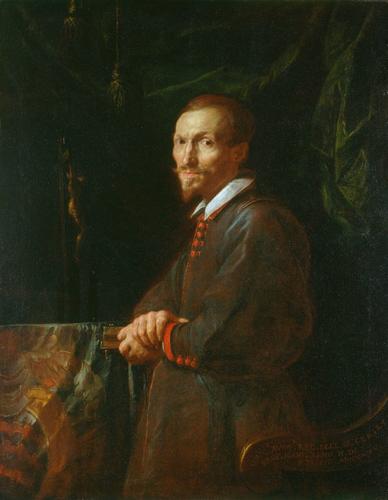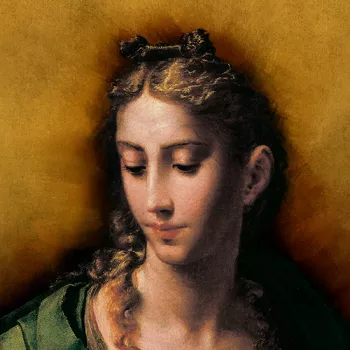Vincenzo Avogadro 1620
Oil on canvas | 115.4 x 90.3 cm (support, canvas/panel/stretcher external) | RCIN 405327
-
The inscription identifies the sitter of this powerful portrait as Vincenzo Avogadro, rector of the church of Santi Gervasio e Protasio in Mantua, and gives his age as 35. In his hands he holds a book, and in the upper left-hand corner is a crucifix. The nervous touch of Fetti's brush strokes delineating Avogado's face against the darkness gives the portrait a haunting quality.
The inscription in the lower right-hand corner of this painting, placed along the arm of the chair, identifies the sitter here as Vincenzo Avogadro, Rector of the church of Santi Gervasio e Protasio in Mantua, and gives his age as 35. The registry of deaths in the State Archive in Mantua records one Vincenzo Avogadro as having died in 1630 at the age of 45 years. Assuming that this is the same man, this portrait must have been painted in 1620. The style of the painting, which accords with Fetti's mature technique, seems to confirm this date. However, the date of the painting in the same inscription appears to read N.D .CX (presumably meaning MDCX, or 1610). There is dark repaint in the area of the date, thus the most likely explanation is that a final X of the date remains hidden from view.
Avogadro stands in three-quarter view in front of a chair and looks out at the viewer over his left shoulder. In his hands he holds a book, and in the upper left-hand corner of the painting is a crucifix. The interior of the room in which he stands, presumably the sacristy of the church, is simply decorated, yet the luxurious fabric of the altarcloth and his richly coloured costume hint at his noble standing. A most obvious comparison can be made between this work and the Francesco Andreini (Hermitage), which sits comfortably within Fetti's oeuvre and has particular similarities to the Royal Collection portrait. Like Francesco Andreini, Vincenzo Avagadro engages the viewer with his gaze, lending a psychological dimension to the portrait and a melancholy quality to the painting.
In the catalogue of the Royal Academy exhibition in 1946, the correct attribution to Fetti was first proposed. Long accepted by scholars, this has recently been challenged by Lehmann, who suggests Daniel van den Dijck as the artist, and Eduard A. Safarik, who raises the possibility that it could be the work of a copyist. Safarik cites the missing letter in the date as evidence that the copyists may have had difficulty reading the original and thus left it out. Furthermore, he characterises the painting materials as extremely poor and the finish not of the artist's usual standard. While the inscription does not seem to have been particularly carefully executed, the technique of the work and the materials used accord well with Fetti's mature style. As found with many paintings of this period, some of the colours have faded noticeably. The blue smalt pigment which Fetti used for the robe of his sitter has darkened dramatically and the nuances of tonal variations in the drapery are no longer as visible as they would once have been. The red pigment used for the collar and the buttons of the sitter's costume have not faded in the same manner, and give an indication of the much fresher original quality the work would have had. The altarcloth in the lower right-hand corner is painted using broad brushstrokes enhanced with short, spontaneous highlights in a manner well used by Fetti in other works. It cannot be disputed that the face of the sitter in the present work is particularly accomplished, painted in a self-assured and confident manner typical of Fetti's mature style. Emerging from the darkness behind him this powerful and mysterious portrait provides an intriguing character study of the Mantuan rector.
Catalogue entry adapted from The Art of Italy in the Royal Collection: Renaissance and Baroque, London, 2007Provenance
Acquired by George III from the collection of Consul Smith in 1762 as by Van Dyck (Dutch and Flemish List, no 21); listed in the Blue Room at Buckingham Palace in 1819 (no 675)
-
Creator(s)
Acquirer(s)
-
Medium and techniques
Oil on canvas
Measurements
115.4 x 90.3 cm (support, canvas/panel/stretcher external)
134.6 x 109.0 x 6.0 cm (frame, external)










